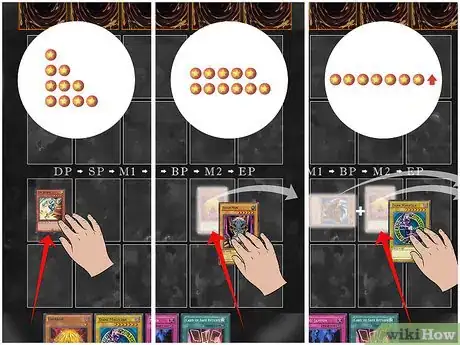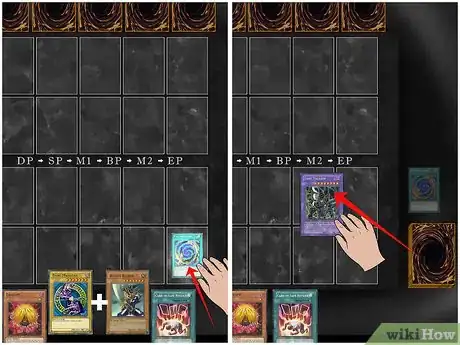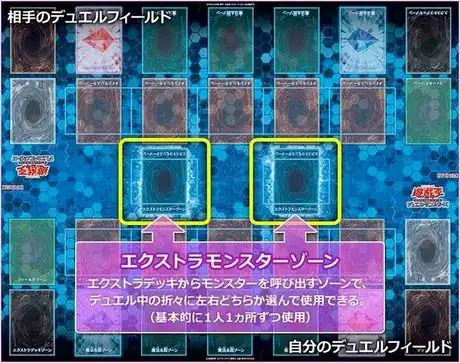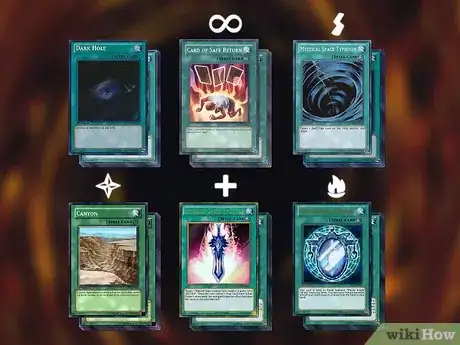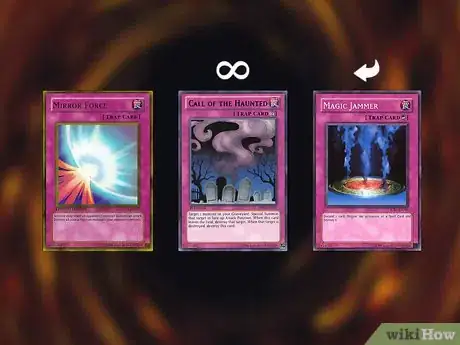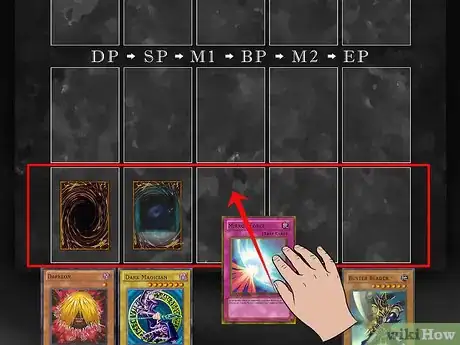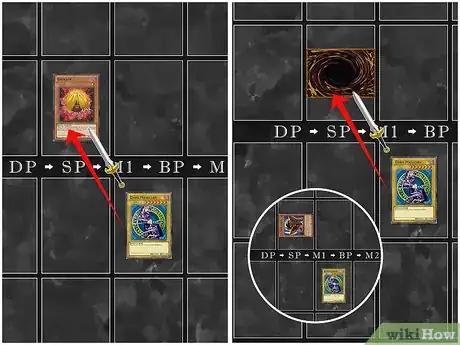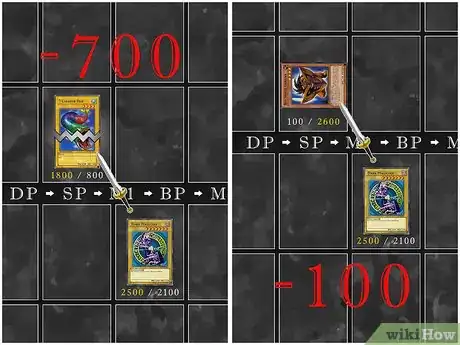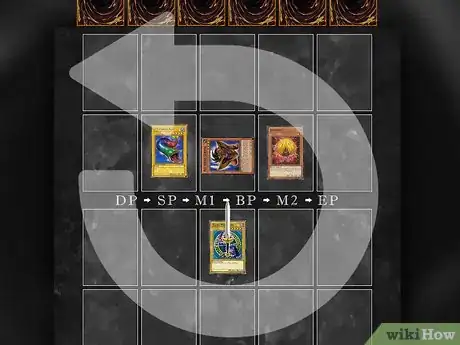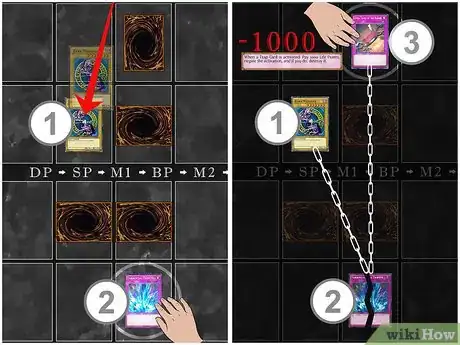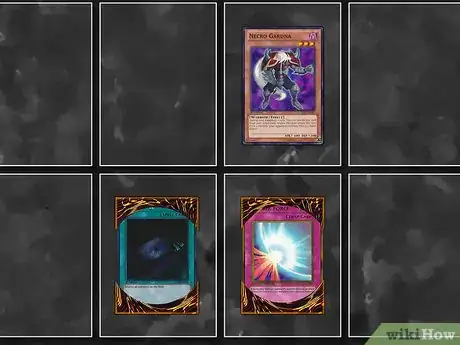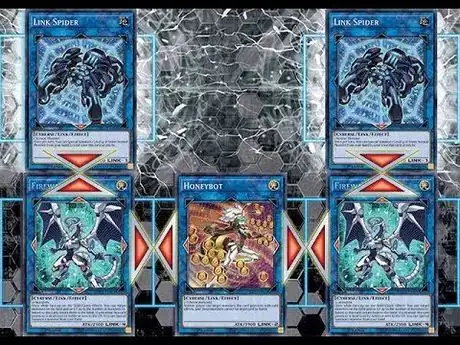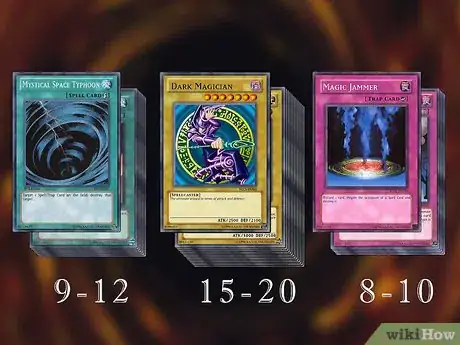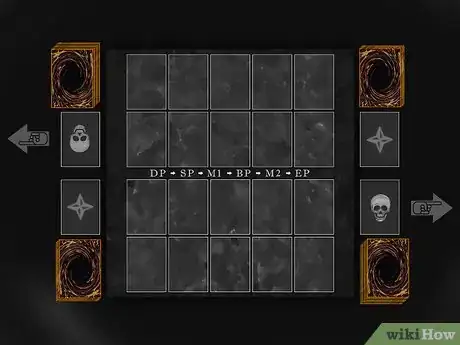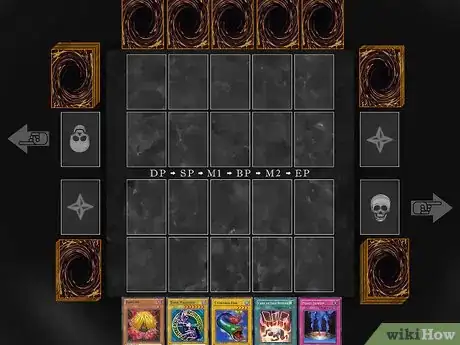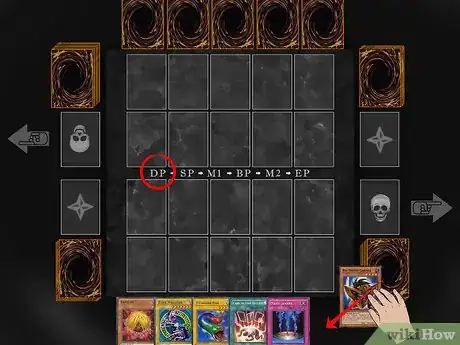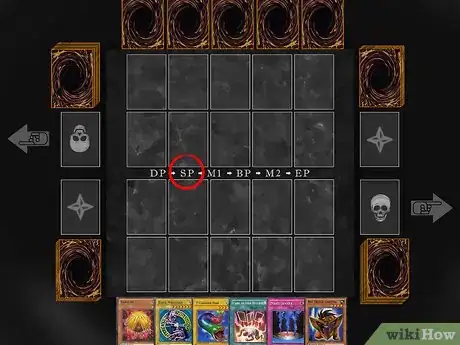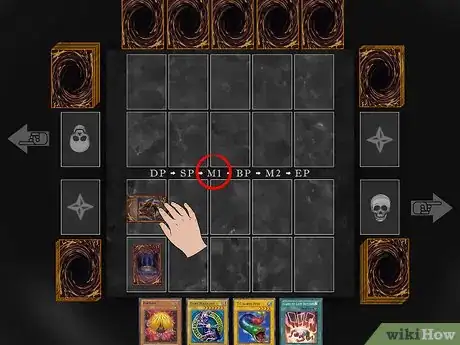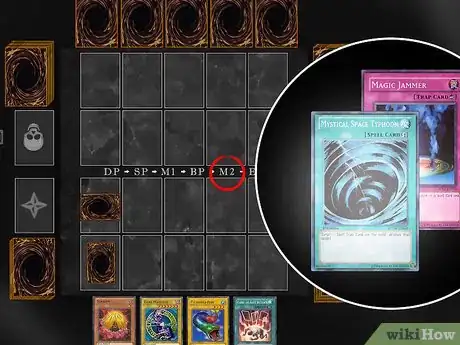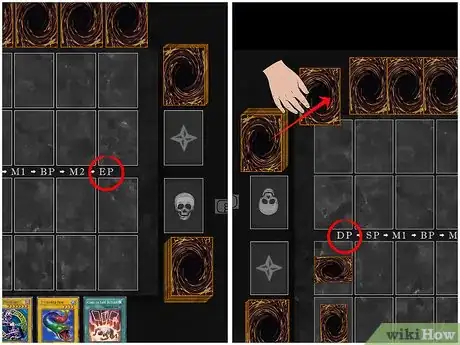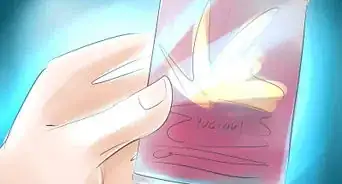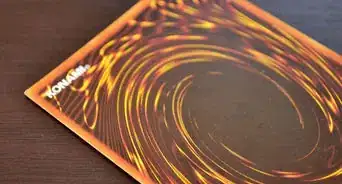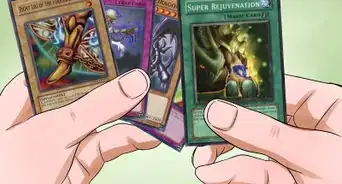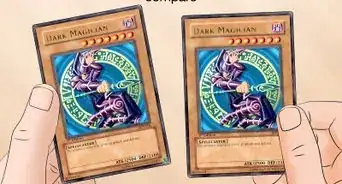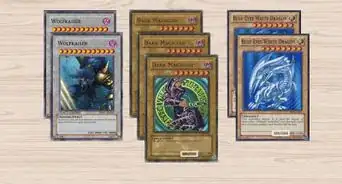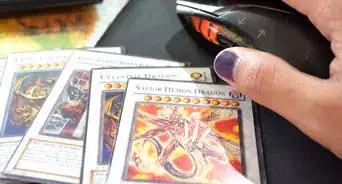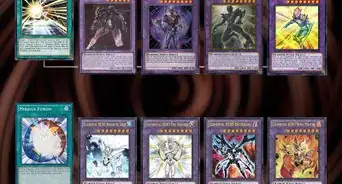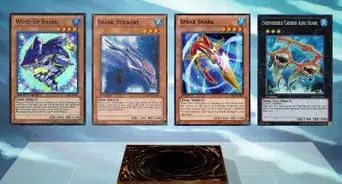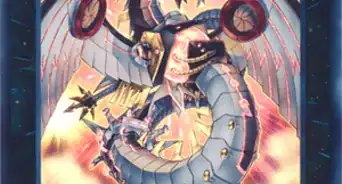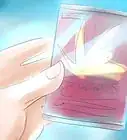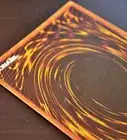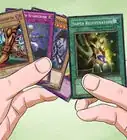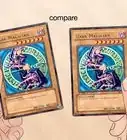wikiHow is a “wiki,” similar to Wikipedia, which means that many of our articles are co-written by multiple authors. To create this article, 116 people, some anonymous, worked to edit and improve it over time.
This article has been viewed 942,338 times.
Learn more...
Yu-Gi-Oh! is a complex trading card game about summoning monsters and using them to defeat your opponents. You may have seen the anime and thought, "I want to play that game". It's full of complicated mechanics and rules, but this article will help you understand them.
Steps
Understanding the Cards
-
1Use monster cards. Monster cards are summoned to attack your opponent’s Life Points and defend your own. They are usually orange (effect) or yellow (normal) in color, but there are many other colors as well. Monsters have levels, ranging from 1-12, which are indicated by the stars along the top, and a symbol in the top right corner indicating Attribute. Above the card text, the Type, the kind of monster, and monster abilities such as Tuner or Flip are written in bold. The Attack and Defense stats are listed as ATK and DEF along the bottom. [1]
- Effect monsters have effects which affect the game, but normal monsters only have lore. Effect Monsters are the most commonly used type of monster, as their effects can be quite powerful. Normal monsters are not as useful, but have some good support and are used in certain types of decks. Extra Deck monsters without an effect are Non-Effect Monsters, neither Normal nor Effect monsters.
- Tokens are a type of monster summoned by an effect. They can be represented by anything small that can indicate attack and defense position. Token cards cannot be in either deck, and can only exist face-up on the field. Therefore they can't be sent to Graveyard or banished for cost, flipped face-down, or become Xyz Material. They are treated as Normal monsters, and are given their name, attack, defense, level, attribute, and type by the card used to summon them. Official Token cards are gray.
- Fusion, Synchro, Xyz, and Link monsters cannot exist in the hand or deck, and must go in the Extra Deck. Xyz monsters have black backgrounds, and Ranks instead of Levels. Synchro monsters are white, Fusion monsters are violet, and Link monsters are blue with a hex background. They each have their own specific summoning methods and must first be Special Summoned using that method before they can be summoned any other way (revived from the Graveyard, etc.). Some of these monsters have special requirements for the monsters used to summon them (known as the materials), which are written on the first line of the text.
- Ritual monsters are blue, and also cannot be summoned unless they are first Ritual Summoned. Most of them are summoned with a specific Spell.
- Pendulum monsters can be any type of monster, and their background color fades to the green color of spell cards on the bottom half of the card. Above the card text, there is a box which contains that card's Pendulum Effects and has the Pendulum Scales on each side. A Pendulum monster can be activated from the hand as a spell card in the left- and right-most Spell/Trap Zones, which become Pendulum Zones while a Pendulum card is placed in them. Unlike Field Spells, Pendulum cards cannot be replaced by putting another Pendulum monster in the same zone. When a Pendulum monster would be sent from the field to the graveyard, it is placed face-up on top of the Extra Deck instead, where it can be resummoned to the field. If you have a Pendulum monster in both Pendulum Zones, you can perform a Pendulum Summon (more on that later).
- Possible monster abilities are Tuner, Spirit, Gemini, Flip, Union, and Toon. Tuner monsters are necessary for Synchro Summons. The other types are self-explanatory.
-
2Summon your monster to the field. A summons is a way to place a monster onto your field. There are three main types of summons: Normal, Special, and Flip. A Normal Summon can be done once per turn, and there is no limit on Special Summons. You can Normal Summon a monster from your hand in face-up Attack Position or face-down Defense Position (called a Normal Set). Level 4 or lower monsters do not require tributes, but for higher level monsters, you will need to send monsters from your field to the graveyard. Levels 5 and 6 require one tribute, and Levels 7 and higher require two. A Normal Summon involving tributes is also called a Tribute Summon.
- A face-down monster is not revealed to your opponent. While face-down, it has no name, attribute, stats, etc. It can be flipped face up by manually changing it to Attack Position (called a Flip Summon), by an effect, or when it is attacked. A face-up monster cannot be flipped face-down, except by effect.
Advertisement -
3Use special summoning: Special summons are done by card effect or as a game mechanic. A monster cannot normally be special summoned face-down, but can be summoned in either attack or defense position. The following are types of special summons.
- A Fusion summon is usually done by using a Fusion Spell card (like Polymerization) and sending the monsters listed on the Fusion monster to the graveyard. Certain Fusion monsters do not require Fusion spell cards (unofficially called Contact Fusion monsters). Fusion Materials are usually quite specific.
- A Synchro summon is done by sending a Tuner monster and 1 or more non-tuner monsters from your field to the Graveyard, and special summoning a Synchro monster from your Extra Deck whose level exactly matches the combined levels of the material monsters.
- An Xyz summon is done by taking two or more monsters on your field with the same level and stacking them on top of each other, then stacking an Xyz monster with the same Rank on top. The monsters on the bottom are now called Xyz Materials, and are not treated as being on the field. Most Xyz monsters have effects that are activated by detaching Xyz Materials (sending them to the Graveyard). If an Xyz monster leaves the field or ceases being treated as a monster, its Xyz Materials go to the Graveyard.
- A Ritual summon is usually done by using the specific Ritual Spell card, tributing a number of monsters whose levels equal the Ritual monster’s level, and special summoning the Ritual monster from your hand. There are exceptions - read your Ritual Spells.
- A Pendulum summon can be done if you have a Pendulum monster in both of your Pendulum Zones. You can Special summon any number of monsters in your hand and face-up on top of your Extra Deck, if their levels are between the Pendulum Scales of the two Pendulum monsters (they cannot equal the Pendulum Scales). You can only perform a Pendulum Summon once per turn.
- A Link summon is done by sending material monsters from your field to the Graveyard which fulfill the Link's requirements. You must use a number of materials equal to the Link monster's Link Rating - the number on the bottom right corner. If a Link monster is used as Link material, it can be treated as a single monster, or as a number of materials equal to its Link Rating. Link monsters have no Level or DEF, and cannot be changed to Defense Position by any means. It has orange arrows surrounding the card art, the number of arrows being equal to the Link Rating, which point to Monster Zones around it. Extra Deck monsters can be summoned to zones a Link Monster points to.
-
4Enter the Extra Monster Zone. Introduced along with Links in Master Rule 4, the two Extra Monster Zones exist between both player's fields, connecting them. Any Summon from the Extra Deck must go to an Extra Monster Zone. Anything that is not a Summon from the Extra Deck - this includes temporary banishing, control change, and returning from control change - must go to a Main Monster Zone. Once you summon to one of the two Extra Monster Zones, it's yours for the rest of the Duel, and the other one automatically belongs to your opponent.
-
5Cast spell cards. Spell cards are a greenish color. They are usually activated from your hand during your turn, and have various effects. There are six different types of spells, and spells other than normal spells will have an icon at the top right near the bold text indicating their type.
- Normal Spell cards are played from the hand onto a S/T zone on the field, and after their effect is applied, they are sent to the graveyard.
- Continuous spell cards have a ∞ symbol. After they are played onto the field, they stay there unless removed in some way, and their effects are applied as long as they are on the field.
- Quick-Play Spells have a lightning bolt symbol. They can be played during any part of your turn, and, if set, during your opponent's turn.
- Field spells have a four-pointed star, and go in the Field Spell Zone when activated or set. Field spells affect the whole field, and stay there unless removed. If you activate a new Field Spell while you already control one in your Field Spell Zone, the previous one is destroyed. Both players can control a Field Spell at the same time.
- Equip spells have a plus symbol. When activated, they are equipped onto a face-up monster on the field, and remain on the field unless removed. An Equip Spell Card is destroyed if the monster is no longer face-up on the field or is no longer a valid target.
- Ritual Spell cards are indicated by a flame, and are used in the Ritual Summoning of a Ritual Monster. They work like Normal Spells, and usually require tributes from the field to summon the specified monster from the hand.
-
6Play trap cards. Traps are meant to be used during the opponent's turn to disrupt their plays. Traps are purple, and will have a symbol in the corner for anything other than Normal Traps. All Trap cards must be Set (placed face-down in a S/T Zone) before they can be used, and they can be activated during either player's turn.
- Normal Traps can be flipped face-up when you want to use them, and when any activation requirements are met. After they resolve, they go to the graveyard.
- Continuous Traps are indicated by the same ∞ symbol as Continuous Spells and function the same way.
- Counter Trap Cards are indicated by an arrow. They act like Normal Traps, but the only cards that can be activated in response to them are other Counter Trap Cards.
Understanding the Game Mechanics
-
1Set Spells and Traps. Spells and Trap cards can be set from the hand during the Main Phase. When they are set, they are placed face-down in an open Spell & Trap Zone. If you set a Trap or Quick-Play Spell, it can't be activated until the next turn.
-
2Prepare your monster for Battle: If your monster is in Attack Position during your Battle Phase, you can attack an opposing monster with it. If your opponent controls no monsters, you can attack directly. Each monster can only declare an attack once per turn. If the monster it battles with is face-down, it is flipped face-up just before damage calculation.
-
3Calculate damage.
- If both are in Attack position, the one with less ATK is destroyed, and its controller takes damage equal to the difference.
- If they have equal ATK, both are destroyed.
- If one is in Defense position and it has less DEF than the attacking monster’s ATK, it is destroyed but its controller does not take damage.
- If it has more DEF, the attacking monster’s controller takes damage equal to the difference, and neither is destroyed
- If the ATK and DEF are equal, neither is destroyed.
- In a direct attack, the opponent takes the ATK of the monster as damage.
-
4Trigger a replay: If, during your attack, the number of monsters your opponent controls is changed, a replay is triggered in which you can choose to attack with the same monster, attack with a different monster, or not attack. You can also choose a different attack target. If you attack with a different monster, the first monster is considered to have already attacked, and cannot attack again for the rest of the turn.
-
5Position yourself for battle: A monster can be in either Attack Position or Defense Position. The position they are in determines which of their stats are used for damage calculation; therefore, monsters with high attack should be in attack position, and monsters with low attack should be in defense position. Also, if one of your opponent’s monsters has a higher attack than all of yours, your monsters should be in defense position to protect you from taking damage. Battle position can be changed manually once per turn for each monster, during your Main Phase. You cannot change its battle position if it was summoned, was set, or had attacked during that turn.
-
6Link cards with chains: To Chain a card or effect is to activate it before another effect has a chance to resolve (be applied). The activation of a card or effect will start a Chain Link. After it is activated, the other player can choose to chain a card to it, which will then become Chain Link 2. This continues until neither player responds to the chain, after which it resolves, starting with the most recent Chain Link. While a Chain is resolving, cards and effects cannot be activated.
- For example: Player A activates “Torrential Tribute”, which becomes Chain Link 1. Player B responds by activating "Seven Tools of the Bandit" to negate it by paying 1000 Life Points. He pays the LP now because that is a cost to activate the card, and happens during the activation and not the resolution. Player A passes on chaining more cards, and so does Player B, so now the chain resolves. Resolution begins with the most recent Chain Link - "Seven Tools". Seven Tools negates “Torrential Tribute”, so it does not destroy any monsters.
-
7Spell speed. Only Quick-Play Spell Cards, Trap Cards, and Quick Effects can be chained to another card as Chain Link 2 or higher. Quick Effects will be designated either by saying they are a Quick Effect or by being able to be activated during either player's/your opponent's turn. An effect must be either Spell Speed 2 or higher or a Trigger effect in order to activate outside of your Main Phase. Quick-Play Spells can only be played during your opponent’s turn if set the previous turn. If a Counter Trap Card is activated, the only cards that can be chained to it are other Counter Trap Cards.
-
8Add an Extra Link: An Extra Link is a way to use Link Monsters to take your opponent's Extra Monster Zone. In order to do this, you need Link monsters that are co-linked to each other (both point to each other) leading from your Extra Monster Zone to the opponent's. Once you have that, you can summon the final Link monster in your opponent's Extra Monster Zone, co-linked to your monster, and that zone's yours while the Link monster sits there. The Links can be summoned in a 'u-shape' or diagonally, in a v-shape. You can also use monsters your opponent controls to complete an Extra Link - if your opponent has 3 co-linked monsters in a row in their Main Monster Zones, summoning 2 Links to the Extra Monster Zones co-linked to those 3 will allow you to complete the Extra Link.
Dueling
-
1Build a deck. To play Yu-Gi-Oh, you must have a deck. The number of cards in a deck must be greater than or equal to 40 cards and less than or equal to 60 cards. It is usually better to have closer to 40 cards in your deck. Your deck should have a good balance of spells, traps, and monsters. A good ratio is 15-20 monsters, around 9-12 spells, and around 5-8 traps. This ratio is not a requirement and does not need to be followed if you already know about deckbuilding. It actually means nothing in practical play. Most of the monsters should be below Level 4, with only about 1-4 (if any) of the higher levels that can’t be summoned any other way. The spells and trap cards should cover for the weaknesses of your deck, and you should have a handful of each of the following: attack protection, effect negation, summon negation, spell/trap destruction. Of course, these numbers are not absolute and will vary depending on your deck, so use what works for you. Your deck will be more consistent if it focuses around a single central archetype or theme.
- An Extra Deck is not necessary for a duel, but is recommended for most decks. Fusion, Synchro, and Xyz monsters are placed in the Extra Deck instead of the Main Deck. You can look through your Extra Deck at any time during the duel, and you can special summon monsters from it during your turn. There is a maximum of 15 cards that can be in the Extra Deck. Your opponent cannot view your Extra Deck, except with an effect.
- The Side Deck is also limited to 15 cards. It is optional, and is good for matches in tournaments. A match is a set of three duels, in which the player who wins two out of three is the winner. A Side Deck contains cards to be used against specific decks that are common or pose a major threat to your deck, but are too situational to put into your main deck. It is not to be used during a duel, but you can swap cards between it and the main and/or extra deck between the duels in a match. After siding, the number of cards in your Side deck must be the same as what you started with.
- You can only have three copies of a single card in your Main, Extra, and Side decks combined. Certain cards are banned or limited for use in tournaments, so make sure your deck is legal if you are going to participate in them.
-
2Start a duel. To start a duel, find someone else to duel with. Shuffle each other’s decks and decide who goes first. This can be done by playing rock-paper-scissors, flipping a coin, or some other suitable method. The player going first cannot draw or attack. Decks that like to set up a field early or use effects that prevent themselves from battling will find it more advantageous to go first, while decks that need extra hand advantage to start their plays or respond to what the opponent does will prefer to go second. Both players start the game with 8000 Life Points.
-
3Place your cards in the right positions. Place your Extra deck at the left of the bottom row, and your deck at the right, with space for five cards in between. These five spaces will be your Spell/Trap zones. Above your deck and extra deck will be your left and right Pendulum zones. The top row will contain the Field Spell zone (on the left) and the Graveyard (on the right). The five spaces in between these will be your monster zones. The banish zone is usually to the right of the graveyard.
-
4Draw your starting hand. Both players draw 5 cards at the beginning of the game as their starting hand.
- Your hand is revealed to you and not your opponent. They can only look at your hand through a card effect. It is important to keep your opponent from seeing your hand and learning about your strategies. During the End Phase, if you have more than 6 cards in your hand, you must discard until you have 6.
-
5Draw a card. You draw a card from your deck at the beginning of your turn, during the Draw Phase. The player who goes first can't draw.
-
6Enter the Standby Phase. Certain effects activate during the Standby Phase. Otherwise, just ignore it.
-
7Move on to the Main Phase. The Main Phase is the most important part of the turn, being the phase in which you will take most of your actions. In this phase, monsters can be summoned, effects can be activated, a monster’s battle position can be manually changed, and spells and traps can be activated or set.
-
8Battle. You can attack using Attack Position monsters you control during the Battle Phase. Entering the Battle Phase is optional. If you do not enter the Battle Phase, you move on to the End Phase and you do not enter Main Phase 2. The player who goes first cannot conduct the Battle Phase.
-
9Conduct your second Main Phase. After Battle Phase, you enter Main Phase 2. In this phase, the same actions as in Main Phase 1 can be performed, except you cannot change the battle position of a card that attacked during the Battle Phase. You cannot enter this phase if you have not entered the Battle Phase.
-
10End your turn. The End Phase is the end of your turn. Certain effects may activate in this phase. After this, it becomes the next player’s turn.
-
11Play until someone loses. Once a player’s Life Points reach zero, they lose the duel. If a player would draw a card but cannot because they have no more cards in their deck, they also lose the duel. Players can also win or lose by card effect.
Community Q&A
-
QuestionWhere can I buy the cards?
 Community AnswerStores like Target or Walmart will carry them. You can also find them in toy store or game/hobby shops, such as Toys R Us or Game Stop. Lastly, you can always buy them online.
Community AnswerStores like Target or Walmart will carry them. You can also find them in toy store or game/hobby shops, such as Toys R Us or Game Stop. Lastly, you can always buy them online. -
QuestionCan a monster attack on the same turn it switched to attack?
 Community AnswerYes, it certainly can.
Community AnswerYes, it certainly can. -
QuestionI do not understand -- apparently I have all god cards and the five headed dragon. I get teased at school because I have good cards but do not know how to play.
 Community AnswerNow you have a good reason to learn the rules if you want :) Once you practice, you'll be able to play against, and maybe even beat, the people who are teasing you. However, don't rely on the power of your god cards or the five headed dragon. (Remember that you have to special summon them or tribute.) Try to improve without them, and then when you're ready to add them to your deck, you'll be even better.
Community AnswerNow you have a good reason to learn the rules if you want :) Once you practice, you'll be able to play against, and maybe even beat, the people who are teasing you. However, don't rely on the power of your god cards or the five headed dragon. (Remember that you have to special summon them or tribute.) Try to improve without them, and then when you're ready to add them to your deck, you'll be even better.
Warnings
- This game can become very expensive, especially if you are playing it competitively.⧼thumbs_response⧽
- In duels, refrain from "stacking". Stacking is a form of cheating in which you arrange your cards in a way that you will draw what you want, when you want them. If caught during an official tournaments, this will ALWAYS get you removed from the tournament. Plus, when facing an experienced duelist, it will rarely work.⧼thumbs_response⧽
Things You'll Need
- A Yu-Gi-Oh! deck
- A Side Deck and Extra Deck (optional)
- Card sleeves, a deck box, a calculator (optional), a notebook (optional), a playmat (optional)
- An opponent
References
About This Article
If you want to play Yu Gi Oh!, collect a deck of cards. Once a turn, use a normal summons to place the monster cards onto your field. When turned face-up, the monster cards are used to attack your opponent, and when placed face-down, they are used for defense. There are also special summons you can play which will give monsters special powers, as well as spell cards which give you or your opponent special effects. You can also use trap cards to disrupt your opponent’s play. To learn how to set up your cards, keep reading!

